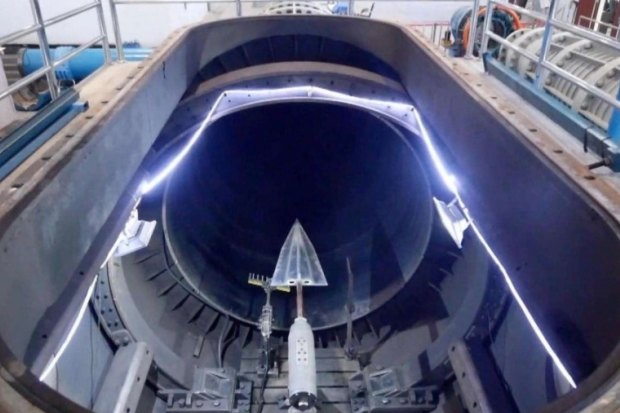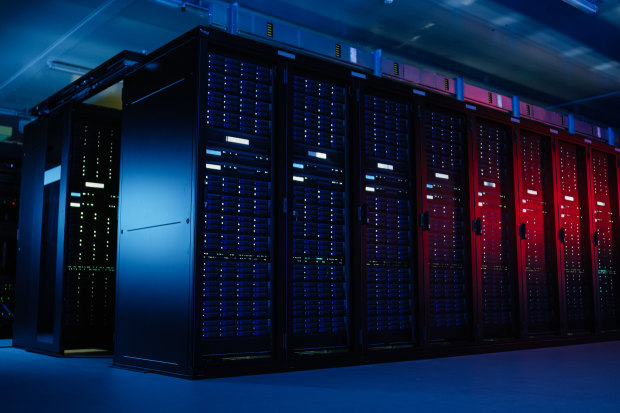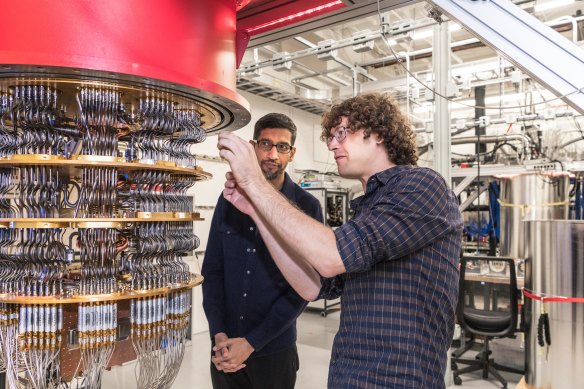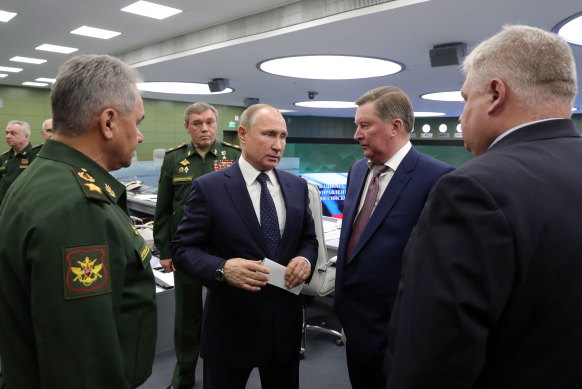Explainer
- Explainer
- Defence
Quantum sensors, sea drones and hypersonic missiles: what are the new frontiers of war?
There’s more than subs in the AUKUS technology-sharing pact with the US and the UK - AI, cyber, quantum, hypersonic missiles and other “undersea capabilities” are on the menu too. How will they change the game?
By Sherryn Groch and Felicity Lewis
Imagine a flying machine-gun that can recognise faces – and pick its own targets. Or a new kind of computer chilled to the temperature of space and able to calculate in seconds what a supercomputer would take millennia to solve. Then suppose you could beam co-ordinates from a satellite to an army base using an unhackable encryption key, or send a swarm of undersea drones to lie in wait for a stealth submarine.
These technologies are no longer in the realm of science fiction; some are already cresting the horizon.Talk of artificial intelligence, quantum technology, hypersonic missiles, cyber weapons and other “undersea capabilities” may have been missed in the fanfare (and shock) of Australia’s plan to build its first fleet of nuclear submarines, but such things are also listed as part of the new technology-sharing AUKUS pact between Australia, the United States and the United Kingdom. The fields are not new, and not just the domain of the AUKUS trio; many also appear in China’s latest five-year plan, for example. But experts say some of these technologies could disrupt the traditional battlefield before Australia’s nuclear submarine fleet is even online.
So how developed are they? Who else is working on them? And how might they change the face of war?

China is building a hypersonic wind-tunnel in Beijing to help it test faster aircraft at up to 30 times the speed of sound.
What does ‘cyber’ have to do with warfare?
War has already changed in one big way. The first act of a major conflict will now play out in cyberspace, says Professor Michael Webb, director of the Defence Institute at the University of Adelaide. “If you think back to the Gulf War, we were fighting first for supremacy in the air.” Today, because of how connected the world is, “we’ll be fighting for supremacy in cyber”.
If you can jam an enemy nation’s satellites to mess with their GPS navigation, or blind their air radar systems, or even shut down their electricity grid, you can sow chaos before you’ve fired a single shot.
The world’s first digital weapon was unleashed in 2009, a highly advanced computer worm known as Stuxnet, built by the US and Israel to damage an Iranian nuclear enrichment facility. An arms race has been under way ever since among security agencies looking to patch vulnerabilities faster than hackers and rival nation states can exploit them.
In many ways, it’s not a new story, says Webb. “There’s always a new edge [in warfare] so instead of using bronze, we’ve updated to iron. What’s interesting now ... is just how fast it’s all moving.”
While the US, China and Russia are thought to have the most advanced cyber capabilities in the world, Israel, Britain, Iran and North Korea also have formidable armies of hackers. In Australia, most attacks considered sophisticated enough to be attributed to another state (from data grabs at our top universities to the infiltration of the Australian Parliament itself) are thought to have come from China.
But some of the biggest and most brazen cyber attacks in history have come from Russia, such as the devastating NotPetya hack that unplugged Ukraine and crashed much of the world’s shipping; and the recent SolarWinds breach that made it into the upper echelons of most Western governments, including the US and Australia.
Australia is still building its own cyber workforce. Its army didn’t have a separate cyber command until 2017; nor does it have the huge arsenal of digital weapons hoarded by America’s spy agencies and Cyber Command.
The frontier of the action is where many of these new technologies overlap.
Through the intelligence-sharing Five Eyes alliance (which also includes Canada and New Zealand), Australia has collaborated to some extent with America in cyberspace, at times even running joint cyber-offensive operations, such as against Islamic State in Syria. “But this [AUKUS] just takes [our access] to another level and a level we haven’t seen before,” Webb says. He hopes the new pact will turbocharge Australia’s cyber capabilities and defences.
At the Australian Strategic Policy Institute, defence analyst Andrew Davies agrees the technology-sharing deal has let Australia “inside the tent”. Up until now, trade restrictions in the US have meant high-tech collaborations could only go so far “because every time you talk to an American about something high tech, they talk to a certain point and then they say, ‘Oh but because of [regulations] I can’t say anything more about that.’ ”

ANU is developing a diamond-based quantum computer, as well as harnessing optics (lasers) to build quantum technologies.
“It happened quicker than I thought it might,” Webb says of the agreement. “But the geopolitics is just making everything a whole lot more urgent. Whether we like it or not, an arms race has been provoked.”
Just as cyber weapons are increasingly having real-world impact, so too is traditional equipment, from tanks to submarines, being brought into the digital fold, talking to one another as well as the soldiers running them. The emerging fields of artificial intelligence and, beyond that, quantum computing now hold the power to dramatically change the battlefield again, experts say.
And the frontier of the action, Webb says, is where many of these new technologies overlap. “So, using AI to fight back and detect cyber threats” faster than a human could, for example. “We can’t get there fast enough. Many of the cyber attacks that are the hardest to combat use AI already.”
While the US brings much of the technological heft to this enhanced defence partnership (such as designs for nuclear subs and long-range missiles), Webb says that in AI and quantum technology Australia is already a research leader in its own right. “We’re not coming with our hands empty; we’re coming with something to put on the table.”
Does ‘AI’ mean killer robots?
In 2020, an Iranian nuclear scientist was gunned down. In September, The New York Times revealed that what had seemed like wild tales at the time of a killer robot pulling the trigger actually stacked up: an automatic machine-gun, programmed to recognise the scientist’s face as he drove his car, had been lying in wait for him. His wife, sitting beside him, wasn’t hit once.
That same year, Turkish drones, packing explosives and facial recognition cameras, were sent out by Libya’s army to eliminate rebels via “swarm attack” in Tripoli. According to a recent UN report, they didn’t even require a remote connection between drone and base. The swarm was, effectively, hunting its own targets.
Defence analyst Marcus Hellyer at the Australian Strategic Policy Institute says a new generation of “smart” sea mines might work similarly, in this case reading the acoustic signature of passing ships to tell an enemy submarine from a commercial oil tanker. Unmanned craft are not a “like for like” replacement for manned vessels such as submarines though, he stresses. And that means not every capability (including what’s needed to protect human crews) has to be packed on board. Instead, you can have a fleet of cheaper, smaller units all working together. You might have sea drones designed for reconnaissance working with sea mines designed to take out enemy ships, both speaking to a “mother ship”, say, a submarine with human crew.

The scene where nuclear scientist Mohsen Fakhrizadeh was killed in Iran in an operation involving an unmanned machine-gun.Credit: AP
These kinds of “disaggregated” autonomous systems now have huge disruptive potential in warfare, Hellyer says. An enemy wanting a relatively cheap and low-risk way to disable a nuclear-powered submarine, for example, could use robot drones, not unlike the new Boeing-designed US Orcas. “I send 10 of them south across the Indian Ocean and let’s say each one of them is carrying 10 smart sea mines. Well, I just dumped 100 smart sea mines off the entrance to our submarine base near Perth. And, automatically, [Australia’s] 100-plus-billion-dollar investment [in submarines] is at risk.”
There are also “little boat drones, about the size of a sailing dinghy” in development that are solar-powered and ideal for surveillance, Hellyer says. “They can just noodle around at three or four kilometres an hour forever” – and tow sonar behind them. “Instead of having your $3 billion frigate out there looking for submarines, you can have a very cheap fleet.”
Of course, for all this to work, you need confidence these autonomous systems can think for themselves, to some degree, whether that’s basic obstacle avoidance, Hellyer says, or finishing the mission if communication channels go down.
“I’m keen to never see a killer drone or killer robot acting on its own.”
And, while machines are already recognising faces, performing surgery and winning games of chess, they’re still a long way from rivalling a human brain. Even the most powerful can break when you throw something new at them, bound by the binary rules of their coding (which is why those driverless cars we keep being promised are yet to arrive).
The autonomous systems used in warfare almost always still have humans in the kill chain, deciding whether to take out a target, Hellyer says. Next, we will probably move to “humans on the loop” rather than closing it, meaning someone will monitor a machine (with the power to intervene) but it will be able to carry out an entire attack solo.
Or, Hellyer says, it may be that the AI becomes like the angel on your shoulder, helping refine targets or run reconnaissance, say, for special forces teams. “That AI may say, ‘We are 80 per cent confident that that is a legitimate target.’ ” It all depends how much you’re willing to bet against that remaining 20 per cent of doubt – and how you program it.
The inherent limits of AI make many experts, including Webb, wonder if we can ever have real confidence in its use at the sharp end of war. As attacks, from missiles to hacks, are made using AI more and more, they will provoke a focus on the most efficient way to respond, which itself will probably involve AI, Webb says. “I think that’ll drive us down that path. But I’m keen to never see a killer drone or killer robot acting on its own. Just building into those systems the kind of ethics or the morality that you need, I’m sure there are people who think that we can do it but, as humans, we don’t [even] do a great job.”
Still, the way we build machines is on the verge of a major quantum revolution, says University of NSW physics professor Michelle Simmons. When it arrives, what a machine can do and how it thinks might be radically different.

Google claimed its quantum computer (pictured) cracked quantum supremacy in 2019, solving a problem other computers would need centuries to solve. That’s disputed by IBM and others, but scientists say there’s proof of concept now.
Why is quantum computing such a big deal?
The future of war (and many industries) is closely entangled with advancing computer power. But there are limits to even the sprawling supercomputers housed in universities today. For example, a computer trying to find the shortest possible route someone could take if they were travelling through, say, 200 cities and back home, has to try each possibility one after another. But “there’s 10 to the power of 375 different possibilities, that’s a one followed by 375 zeroes,” says ANU quantum physicist Ben Buchler. “No computer could ever solve that. At least, no kind we have now.
“A quantum computer will, essentially, try all these different paths simultaneously. You can write a program that senses which path is the shortest,” he says.
So how do they work? “It’s not black magic,” laughs Simmons. “There is actually mathematics behind it.”
Instead of running a computer on traditional transistors or “bits” that can switch between on or off, a quantum computer uses “qubits”. They can be both on and off at the same time. Imagine a coin spinning on its side. Until it stops and lands on one side or another, it could be heads or tails. It’s both.
This strange concept of “superposition” underpins quantum physics, says Simmons, who is at the frontier of the global quantum race, building qubits out of atoms in silicon. If you break down the world to its smallest level, the things we take as a given, such as an object’s fixed location in the world, become less certain. We cannot know for sure where they are until they are measured. But just the act of measuring particles that small changes their quantum state. So, things are said to occupy “superposition”, or many potential states at once.
Even more spookily, particles (including our qubits) can be “entangled” – what happens to one will affect another that it is entangled with and vice versa, even if they are far apart. Using this phenomenon, scientists have already sent entangled lasers across rooms and even into space (as Chinese scientists demonstrated in 2017), and this could be used to encode secure messages, say, between satellite and army base, Buchler says.
“It’s one of the reasons it’s so scary. It will render a lot of our encryption obsolete.”
Quantum computing will allow us to simulate nature for the first time as it actually is, Simmons says, from a chemical reaction to a weather forecast, solving problems scientists have never been able to crack with regular computers.
The problem is that, for all their sensitivity, quantum computers are also incredibly fragile. They use things such as microwave pulses and electric fields to push qubits into a superposition spin, and entangle them long enough to harness. But even the tiniest external change can throw off these quantum states. “There’s so much noise in the universe,” says Buchler. “Most of them you have to cool right down just to stop the vibrations.”
Still, while we won’t have a quantum chip in our phones any time soon (and regular computers will still be needed), Simmons expects to see quantum computers solving real-world problems (with commercial applications) in the next five to 10 years. “And with the amount of investment that’s been pouring into the field lately it could even be earlier.”
At the moment, the largest quantum computers are less than 100 qubits. When they get to a few thousand or a million qubits, Buchler says, they will be able to crack encryption, which safeguards everything from our banking transactions to spy and military networks. That’s a game-changer for defence, says Webb. “It’s one of the reasons it’s so scary. It will render a lot of our encryption obsolete.”
The way to fight back is with quantum encryption, Buchler says, using entanglement to “teleport information” in a new form of encryption “guaranteed by the laws of physics”.
Others are excited by the possibility that quantum computing will speed up AI learning. But, with AI already helping quantum scientists such as Buchler in the lab, he expects “AI will be helping us build better quantum computers long before quantum computers help us build better AI”.
The unparalleled sensitivity of quantum technology means it also opens up enormous potential in refining sensors – such as for finding a stealth submarine or even seeing around corners. Some of those technologies are already proven, Buchler and Webb say. The challenge now is scaling them up into a product that can be used in the field, mounted to a plane or a ship, for example.
“If you’ve got a plane and you’re flying along looking for a sub, you can try and detect the magnetic signature from its metal,” Buchler says. “If you’re looking for tunnels underground, there will be less ground beneath you so you can use a quantum sensor to detect how gravity is different locally.” Meanwhile, Webb’s team is developing a suite of quantum sensors honed to pick up even the faintest radio signals (from enemy communications, for example).

Russian President Vladimir Putin (centre) watches a test flight of the Avangard hypersonic system in 2018.
What are hypersonic weapons?
In all of Australia’s defence white papers that Webb can remember reading down the years, there’s been an assumption that if things heat up, “we’ll have plenty of warning” before conflict breaks out, 10 years or more. But in the latest update, he says, that was no longer the case. “We’re inside the window. And [some feel] if things are going to heat up, it’s happening in the next five years.”
That 2020 update also flagged Australia needs more long-range firepower, and the federal government now has big plans to build missiles on shore. “There’s a lot of frantic activity going on in Australian industry ... to get a piece of this missile action,” says Hellyer. “The Defence Department’s missile shopping list over the next couple of decades [is] potentially close to $100 billion [worth of missiles and surrounding systems].”
One particularly impressive-sounding type of weapon, which Australia plans to continue working on with the US, is hypersonics. “The speed of sound is usually measured in Mach numbers, in honour of Austrian scientist Ernst Mach,” Russian President Vladimir Putin explained in an address to Russia’s Federal Assembly in 2018. “One Mach is equal to 1062 kilometres per hour at an altitude of 11 kilometres. The speed of sound is Mach 1, speeds between Mach 1 and Mach 5 are called supersonic, and hypersonic is above Mach 5.”
“That’s the big threat, that you have no time to react. It would come down to seconds.”
Russia, he went on, already had high-precision hypersonics, able to hit speeds as high as Mach 20 in some cases, as well as dodge defence systems.
Hypersonic weapons are designed to travel at faster speeds than “standard” ballistic missiles while also being manoeuvrable. “That’s the big threat, that you have no time to react,” says Webb. “It would come down to seconds.”
The US is spending billions of dollars on hypersonics, and wants a weapon operational in the next few years. Meanwhile, its air force has given grants to groundbreaking fundamental science being done at the University of Queensland’s Centre for Hypersonics, which has been involved in scramjet flight tests since 2002 (a ramjet is a supersonic engine; a scramjet is hypersonic and has applications for space flight).
When an object is hurtling through the atmosphere about Mach 5 or higher, the air flowing around it changes its chemistry, and different laws of physics and fluid mechanics apply.
“The science of hypersonics is really understanding how these extreme thermal chemical effects and strong shockwaves affect the flow [over vehicles],” says the centre’s Professor Vincent Wheatley.
China’s military hypersonic projects include Starry Sky-2, a prototype aircraft that reached Mach 6 during tests in 2018, and countries such as France, India, Japan and Germany are also investing in hypersonics. Meanwhile, work is under way to stop them coming, says Webb, including harnessing AI to spot hypersonics faster on radars, targeting launch sites before the missile hits the air and even pulling out direct-energy weapons (from lasers to microwave beams) to shoot them down or blind them before they reach their target.
But Davies notes there’s a lot of “hype around hypersonics, if you’ll excuse the pun”. He points to a recent report by investigative physicists David Wright and Cameron Tracy, published in Scientific American, which concludes that “hypersonic weapons may have advantages in certain scenarios but by no means ... constitute a revolution”. They may not even be as stealthy as believed.
Still, the nervousness that hypersonics have induced already is concerning, they say, because it could prompt rash responses to a missile warning, “increasing the chances of blundering into conflict”.
For some commentators considering the new AUKUS alliance, the show of force against Chinese aggression that it represents is itself ratcheting up tensions unwisely.
But even though news of the pact has provoked anger from Beijing already, Webb hopes Western nations working more closely together will “actually settle things down. It just raises the bar and, hopefully, it raises it too high for China to step over.”
Let us explain
If you'd like some expert background on an issue or a news event, drop us a line at explainers@smh.com.au or explainers@theage.com.au. Read more explainers here.